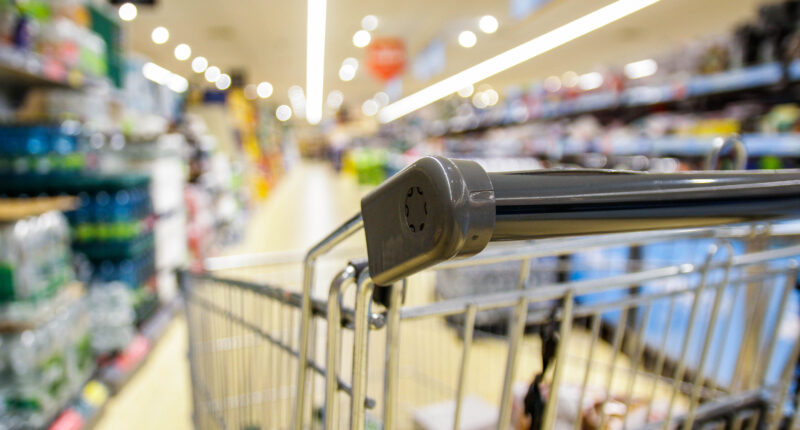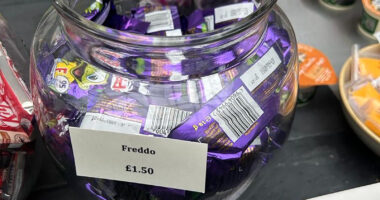THE weekly shop has become a pricey ordeal as the cost of living crisis continues.
Nearly 70 per cent of households are “extremely” if not at least “very” worried as the average cost of groceries rockets by around £833 a year, according to analysts at brand consultants Kantar.
Many of us are tightening purse strings or switching to cheaper alternatives in a bid to pocket our pennies – but it turns out shops have cheeky secret codes they use which could help save you money, speed up the shop and make your food last longer.
Money-saving expert Gemma Bird – aka Money Mum – tells The Sun’s Kirsten Jones how to find the savings hidden on supermarket shelves.
FRESH VEG
LAST year, some shops ditched the best-before dates on pre-packed fruit and vegetables in a bid to reduce food waste. But it’s not all guess work for us trolley pushers.
Tesco shoppers can find out how fresh the food is through a two-figure code.


As seen on this packet of asparagus, you’ll find a letter and a number on the front of each pack.
This one reads F22, which means June 22, and F23 means June 23.
There’s set letters for every month on Tesco shelves. For example, A is January, B is February and so on.
This code will reassure if we can get a few more days out of our produce before going brown.
Most read in Money
EGGS
BRITISH Lion eggs – sold in Asda – have a red lion logo, which means the hens have been vaccinated against salmonella.
So, if you undercook your omelette or even eat an egg raw, there’s no nasty bacteria in there to wreak havoc on your stomach.
Next to the lion, you’ll find a number between zero and three. This tells you how the eggs were farmed.
A lower number means the hens may be happier and have more space to roam.
As seen here, it reads zero which means is organic. One means free range, two is barn hens and three is caged.
You’ll also find a best before date on the eggs, too.
It might take a few extra minutes to spy them in the aisle, but knowing what these little numbers mean will massively reduce food waste, as you’ll know exactly when your eggs go out of date.
WEIGHT
YOU will spot a large lower case “e” on tons of products from meat and pasta to packaged vegetables.
This tells you the estimated weight of the product and that value will never be less than the actual weight printed on the pack.
For example, if you picked up this pack of mature cheddar from Tesco that says 250g along with this symbol, you might actually be getting a few grams more.
People might say you are being incredibly picky but a few extra grams gives you more value for your money.
And let’s face it, every little helps in this cost of living crisis.
BUDGET GOODS
WHY pay more for the same product?
Loads of budget and branded food is made in the same place, and a tiny product licence code will prove it.
On each packet, usually next to the best-before date, is an eight-digit batch code.
For example, this Tesco spaghetti, top, costs 90p for 500g, while its budget brand Hearty Food Co spaghetti is 35p.
Yet their codes are the same so they are made in the same place.
You’ll find the same with budget versus branded medicines such as painkillers.
A quick check for the PL code will stop you getting ripped off and those saved pennies – and often pounds – will soon add up.
BREAD
NOT all of us can throw a loaf in the trolley without checking the price.
If you want to save time and money in the bread aisle, check what colour the bag tag is.
Some supermarkets use different coloured bread tags to identify which brand you are buying.
For example, in Tesco, pricey Finest bread has a silver tag, Hovis is gold, Kingsmill is white, Warburtons is red and their own budget brand is yellow.
So if the bread is stacked top-end first there is no need to pick it up – just look at the coloured tag for the loaf that’s best for your budget and you are good to go.
TESCO DEALS
IF you are a regular at Tesco, there’s nothing better than a Clubcard deal to chop a few pounds off the price of your shopping.
You’ll never miss a deal again with this clever code. Let’s say you’re shopping for beans, you’ll see a blue and yellow Clubcard price for it on the shelf.
The original price will be on the left – below it will be a six-digit code.


Those numbers are the date the discount will end.
In the example above – 230905 – the discount ended on September 23, 2005.















